Rebuilding the Ford 5.4L
by Doug Anderson, Contributing Editor
Doug Anderson is president of Grooms Engines, Parts, Machining, Inc., located in Nashville, TN. He has authored numerous technical articles on engine rebuilding for Engine Builder magazine for more than 15 years. Anderson has also made many technical presentations on engine building at AERA and PERA conventions and seminars.
The 330/5.4L Ford engine was introduced in 1997 as the "big brother" to the 4.6L and replaced the 351W in Ford pickups and vans.
The 5.4L is actually a 4.6L with a taller deck and a longer stroke (3.55˝ x 4.16˝ vs 3.55˝ x 3.54˝), so the two engines share some common components including th
e heads and cams. However, the block, crank and pistons are all different, just like they were on the 302 and the 351W, so it�s important to know exactly what fits and what doesn�t before trying to rebuild this engine.Ford has used the 5.4L SOHC in quite a few of its trucks and sport utility vehicles. It�s been the standard engine in the heavy duty F250/F350 pickups and the Excursions and optional in the F150/F250 pickups, the Econoline vans and the Expeditions since �97. There was also a DOHC motor that was introduced in the middle of �99 that has been used in all of the Lincoln trucks and sport utilities since then.
Most of the 5.4Ls in service are gas engines (VIN L), but there are a few CNG versions (VIN M) and some flex-fuel (VIN Z) motors, too, along with the supercharged engines that came in the Lightning pickups (VIN 3). The DOHC engines (VIN A) were used only in the Lincoln Navigator and the Blackwood pickups.
Ford built about 375,000 of the 5.4L engines in �97 and has assembled close to 500,000 a year every year since then, so there are nearly 3 million of them out there now, just waiting to be rebuilt.
All of the 5.4L engines were built in the Windsor plant except for the DOHC and Lightning versions that were built in the Romeo plant, but these engines used the Windsor architecture, too, so the 5.4L engines aren�t nearly as confusing as the 4.6L was with all of its variations.
There are two 5.4L blocks with two cranks, two different SOHC heads that came in two different flavors, one DOHC head, eight cams and three different pistons, not including the CNG, flex-fuel and supercharged motors that aren�t included in this discussion.
So, lets take a look at the 5.4L, one piece at a time, to see how it�s been put together and what Ford has changed from year to year.
BLOCKS
There have only been two blocks used for the 5.4L, one from �97 through �01 and one that fits �02 and later.1997-�01
The original block for the SOHC was a F75E-AC/AF casting that�s easily identified by the "X" gussets just above the pan rail on both sides of the block.
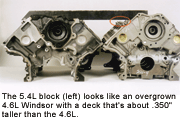
The 5.4L still looks like the 4.6L Windsor with the dowel pins for the main caps, but the deck is abou
t .350˝ taller to accommodate the longer stroke. The DOHC motor came with a F75E-AG casting that�s identical to the F75E-AC/AF block except that there�s one hole on the driver�s side not drilled, but it can be used for a SOHC application as long as this missing hole is drilled.2002
Ford introduced a new "NVH" block in 2002. It�s a 2L1E-A3C casting that was apparently designed to reduce "noise, vibration and harshness (NVH)." We haven�t actually seen one yet, but the Ford microfiche says it can�t be retrofitted for earlier applications, so there must be some significant differences between the early and late blocks that will cause problems if they�re interchanged. Given this warning from Ford, we probably ought to keep these blocks separate until we know more about the differences.
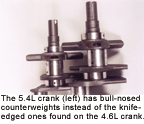
CRANKS
Ford has used two different cranks in the 5.4L, a steel forging and a cast iron version. Both have an eight bolt flange for the flywheel.
1997-�98 SOHC
The original steel crank came with a F75-E, F75-1E or F75E-AE forging number. These cranks are easy to spot because they have an eight-bolt flange and bull-nosed counterweights instead of the knife-edged ones found on the 4.6L Windsor cranks.
1999-�02 SOHC
The steel crank was replaced by a cast iron crank for all the SOHC engines (except the Lightning pickups) in �99. It�s a XL3E-BA casting that has bull-nosed counterweights, too.

1999-�02 DOHC
The Ford microfiche shows the DOHC motor with the cast iron crank, but all the early cores we have seen have had steel cranks, so we�re not really sure which one should be used in these engines. We suspect Ford built some early �99s with steel cranks before switching over to the cast iron ones later in the year, but we won�t know for sure until we see some more cores. Meanwhile, it�s probably okay to use either crank for these engines.
RODS
There�s only one rod that�s been used in all the 5.4L engines. It�s made of powdered-metal, has a cracked cap, and it�s bushed on the small end, just like all the rest of the Windsor rods.You can�t cut the cap to recondition the rod, but that�s not really a problem because most of the bearing companies supply oversized O.D. rod bearings for the big end along with bushings for the small end, so these rods can be "reconditioned" anyway.
None of t
he rods for the modular motors have casting numbers on them so they all have to be identified by sight, but that�s easy to do because the 5.4L rods are about .725˝ longer than the 4.6L rods; they measure 6.657˝ center-to-center compared to 5.933˝ center-to-center for the 4.6L.PISTONS
Ford has used three different pistons in the 5.4L. There�s one for the "not power improved" SOHC , one for the "power improved" SOHC and another for the DOHC motors.
1997-�99 SOHC
The pistons in the early 5.4L engines had a shallow dish that gave a 9.0:1 compression ratio with the "not power improved" (NPI) heads that had the big chambers.

1999-�01 SOHC
When the "power improved" (PI) heads were introduced in �99, Ford increased the size of the dish in the piston to compensate for the smaller chambers in the "PI" heads while still maintaining the same compression ratio.
1999-�01 DOHC
The DOHC Lincoln engines came with flat top pistons because the chambers in the four-valve head were bigger than the ones on any of the SOHC heads, including the original "NPI" heads, and the DOHC engine had a slightly higher compression ratio (9.5:1), too.
HEADS
There have been two different head castings used for the SOHC motors, each with two variations, and one DOHC casting that was used on both the right and left side of these engines.All of the SOHC heads are Windsor castings, so they have individual caps on each cam journal and four 10 x 1.5mm holes in both ends of the heads, but the DOHC heads are Romeo castings, so they have ladder caps and four 8.0 x 1.25mm holes on both ends.
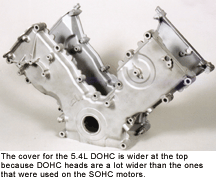
1997 (through 7/20/97) SOHC
�
97 (7/21/97) through �99 SOHC"Not Power Improved" Heads Ford made one minor, but important, change to the "NPI" head late in 1997; the intake gaskets were modified and the blind holes for the alignment pegs were moved over to the opposite side of the ports so they were closer to the head. It appears that Ford made this change only on the F75E castings, but it�s best to check all of the 5.4L "NPI" castings to be sure you get the right heads on the right engine, or make sure that you send the gaskets that match the heads that were installed on the long block.
1999-�01 SOHC "Power Improved" Heads
The "power improved heads" with the square intake ports were introduced in �99. They had bigger intake valves, different springs and a heart-shaped chamber with a modified swirl-fin behind the intake valves. They�re all XL3E castings.
NOTE: The "PI" heads weren�t used on everything in �99, so be sure to have your customer actually look at the intake ports before selling an engine or you will have about a 50/50 chance of selling the wrong engine.
2002 "Power Improved" Heads
Ford continued to use the "PI" heads in 2002, but they revised the intake gasket again, so they moved the two dowel holes back over to the valley side of the ports. There are two versions of the later gasket, one that has a coolant restrictor built into the gasket and one that doesn�t, so rebuilders need to be especially careful when supplying gaskets for these late model applications. This latest version of the "PI" head is a 2L1E casting.

1999 through �01 DOHC Heads
The XL1E-AE DOHC casting showed up mid-year in �99 on the Lincoln Navigator and was used up through 2001 on the Navigator and the Blackwood. These heads were built in the Romeo plant along with all the other DOHC heads for the Lincoln cars and Mustang Cobras, but this casting number doesn�t match any of those found on the car heads, so we believe these castings are unique to this application.
The DOHC head casting has three holes for the secondary chain tensioners on both the front and the top of the #1 bulkhead, so it can be used on either side of the engine as long as the oil hole for the tensioner on the opposite end is plugged off.
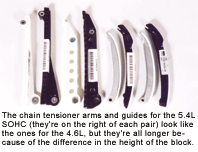
Something Else To Know
The 5.4L seems to be having a lot of problems with stripped spark plug threads. Both the head and the spark plugs only have five or six threads, so it�s easy to strip them out if someone tries to remove the plugs when the head is hot or overtorques them during installation. Ford recommends 7 to 15 pounds of torque, which doesn�t seem like enough to some people who have big wrenches. Some of the plugs weren�t torqued properly at the factory, either, so they slowly worked themselves loose until they were literally blown out of the head, coil pack and all.
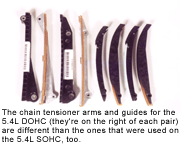
Rebuilders should check the spark plug threads carefully and repair any of them that even look questionable. Some rebuilders are actually installing inserts in all of the spark plug holes to avoid problems in the field. We�re familiar with three different repair inserts: the ones that are made of stainless steel, like Heli Coil; the steel inserts made by Time Fastener; and the hard anodized aluminum ones that are made by Lock-N-Stitch.
Each design has its pros and cons, so it�s up to each rebuilder to decide which one he prefers to use in his shop. Time-Serts are available through Enginetech at 800-869-8711 and the Full-Torque inserts are available through Lock-N-Stitch at 800-736-8621. Whichever insert you decide to use, just make sure you check the treads and fix the ones that are suspect or you will get to fix the problem when the engine comes back home again.CAMS
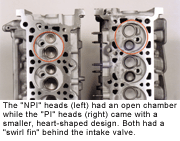 The cams for the 5.4L are all hollow designs with pressed-on lobes. There are right and left cams for the SOHC motors along with the right and left intake and exhaust cams for the DOHC.
The cams for the 5.4L are all hollow designs with pressed-on lobes. There are right and left cams for the SOHC motors along with the right and left intake and exhaust cams for the DOHC.
The SOHC heads are made in Windsor, so the cam gears are pressed-on, but the DOHC heads are made in Romeo, so the gears are bolted-on.
1997 thru �99 SOHC with "NPI" Heads
The "NPI" heads came with a "mild" grind that worked well with the small oval ports found on these heads. The right hand cam had a F65E-6251-BA identification number on the barrel and the left cam had F65E-6C255-AA on it.

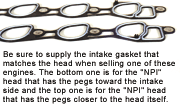
1999 through �01 SOHC with "PI" Heads

1999 thru �01 with DOHC heads
- Right intake: XL1E-6A270-BB YL7Z-6250-AA
- Right exhaust: F2LE-6A272-AG YF3Z-6250-AA
- Left intake: XL1E-6A271-BB XL1Z-6250-CA
- Left exhaust: F2LE-6A273-AG YF3Z-6250-BA

All four of them are hollow with pressed-on lobes, but the cam gears are bolted-on just like all the others that were built at the Romeo plant.
TIMING COMPONENTS
There are two sets of timing components for the 5.4L engines, one for the SOHC and one for the DOHC.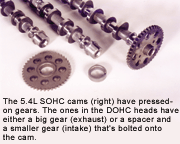
1997-�01 SOHC
The tensioner arms and chain guides for the 5.4L SOHC all look similar to the ones used on the 4.6L, but they�re longer because the block is taller. The tensioners themselves are the same as the later, thick ones that are used on the 4.6L with right, left and universal versions. The OEM part numbers for the chain guides and tensioner arms are as follows:
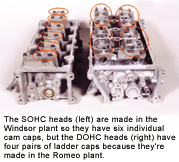
- Timing Chains F6TZ-6268-AA
- Tensioner Arm (left) F85Z-6M274-AA
- Tensioner Arm (right) XL1Z-6K255-AA
- Chain Guide (left) 2L1Z-6K297-AA
- Chain Guide (right) 2L1Z-6M256-AA
1999 through �01 DOHC
The DOHC engine used the same crank and cam gears as the 5.4L SOHC and had the later style right, left and universal tensioners, but most of the guides and tensioner arms were unique to this application:
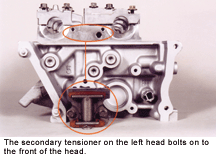
- Timing Chain F3LY-6268-B
- Tensioner Arm (left) F85Z-6M274-AA
- Tensioner Arm (right) XL1Z-6K255-AA
- Chain Guide (left) 2L1Z-6K297-AA
- Chain Guide (right) 2L1Z-6M256-AA
FRONT COVERS
1997 through �01 SOHC
The SOHC motor came with a unique front cover that had either a F75E or a F85E casting number on it. Both castings are the same except for some
additional gussets on the inside of the later version, so they can be used interchangeably.
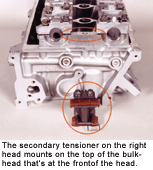

2002 SOHC
The SOHC motor is supposed to have another front cover in 2002. We�re told that it�s a 2L3E casting that has a revised mounting pad on it, but we can�t confirm that information because we haven�t seen one yet. Be sure to watch for it and compare it to the F75E/F85E before putting it on a motor.
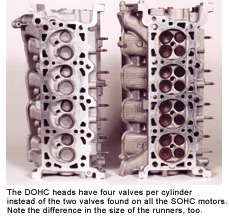
1999 through �01 DOHC
The DOHC motor came with a XL1E-6C086-AB front cover that�s wider at the top because the DOHC heads are quite a bit wider than the SOHC heads. It�s unique to this application.
That�s the story on the 5.4L. These engines are in lots of trucks that are being worked hard, so there�s a growing market for a remanufactured 5.4L engine. This information should help you build the right one the first time so you can sell some more of these motors and get your share of the business. EB
Thanks to Roy Berndt at the Production Engine Remanufacturers Association for his assistance with the research of this article.